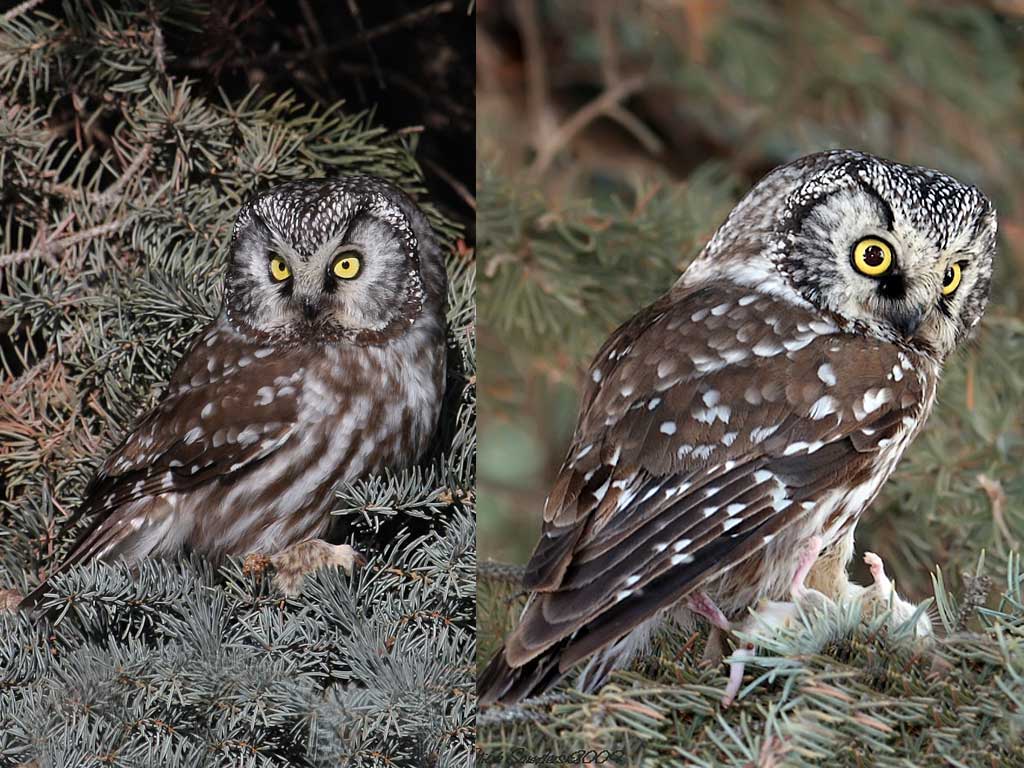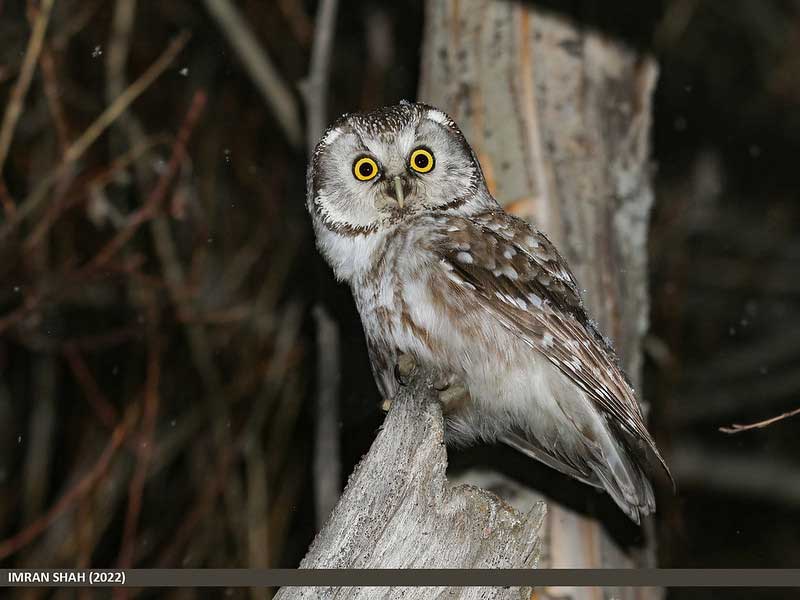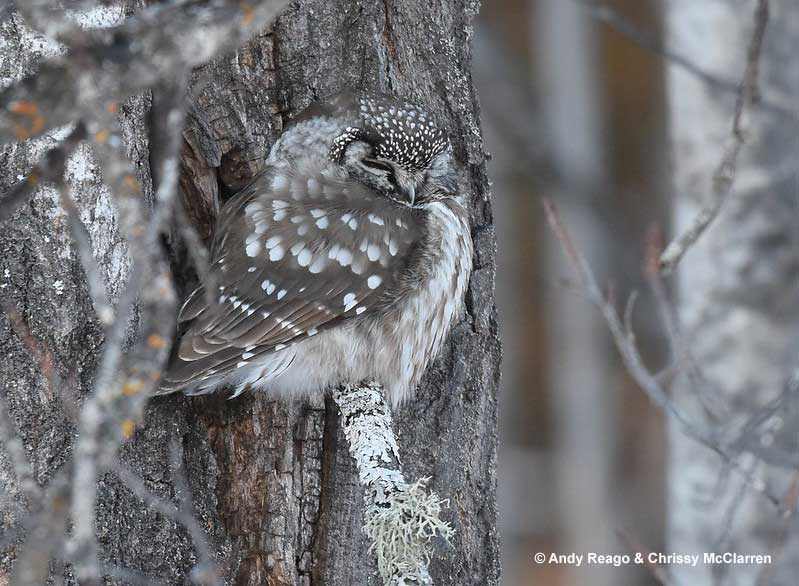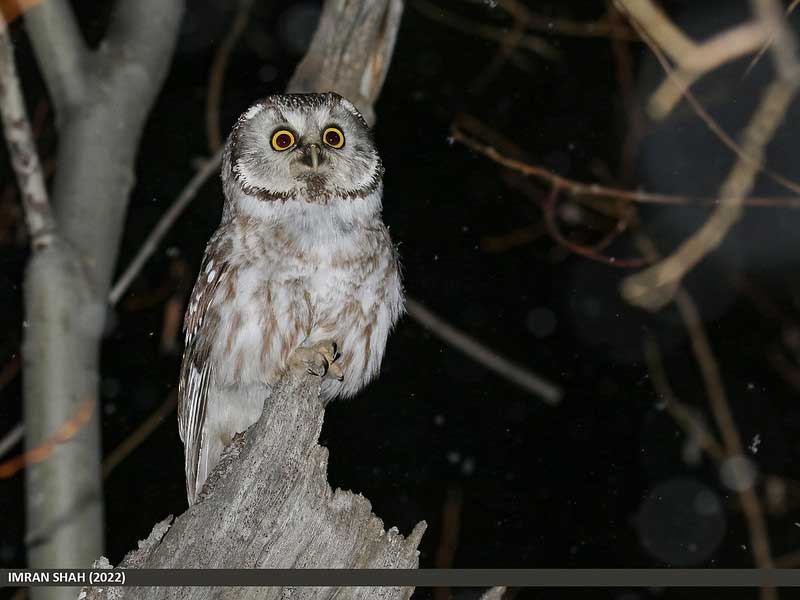The Boreal Owl (Aegolius funereus) is a small, dark brown owl with a black and white head and yellow eyes.
This small nocturnal raptor occurs in boreal forests in Alaska and Canada, and in high elevation forests in the Rocky Mountains. It also lives in similar habitats in northern Eurasia, and occasionally migrates to woodlands just south of its breeding grounds.
Boreal Owls are hard to see, even on breeding grounds in Alaska and northern Canada. However, every so often, small numbers migrate to parks and woodlands in the northern USA and southern Canada.
If you are visiting those regions in the winter and see Blue Jays mobbing something in a conifer, take a closer look, it might be a Boreal Owl!
On this page
Identification
Male
It has a rounded or slightly square-shaped head with black and white spotting and markings on its crown, and a cold, gray and white face.
Male Boreal Owls are 8.26 to 9.84 inches long, have wingspans of 21 to 22 inches, and weigh 3.2 to 5 ounces. They also have a thick black border on the edge of their face, and white markings between their eyes.
Female
The female Boreal Owl looks just like the male but is noticeably bigger. Like male birds, females also have dark brown upperparts with some pale spots, and white spotting in their wings. They also show the same black and white pattern on their head.
Female Boreal Owls are 9.8 to 11 inches long, have wingspans of 23 to 24 inches, and weigh 4.6 to 7.5 ounces.
This owl species also has pale underparts with thick, dark brown streaks and other markings.
Vocalizations
The male Boreal Owl’s song is ten or so, fairly loud, rising, tooting notes. The female Boreal Owl doesn’t sing, but she does make loud, brief screeching calls and makes a hissing sound when disturbed on her nest.
Food
The Boreal Owl mostly feeds on small mammals, especially rodents. They eat lots of voles, mice, shrews, and other small animals including Northern Flying Squirrels and other species.
These small owls also catch a fair number of birds, including thrushes, warblers, juncos, and other small birds. Once in a while, they also prey on young Snowshoe Hares and other similarly-sized mammals, and occasionally catch insects too.
Boreal Owls are highly nocturnal and mostly feed at night. However, during summer months in far northern regions with brief nights, they also hunt during the day.
These owls hunt by waiting on a perch in and at the edge of the forest, around six to twelve feet above the ground. When they see or hear a rodent, small bird, or insect, they fly down to catch it with their talons.
They can catch prey under snow, under vegetation, on open ground, or, even take small animals from branches.
If the Boreal Owl is waiting but doesn’t detect prey after ten minutes, it silently flies to another perch and carries out the same procedure. Over the course of the night, this small owl moves between several perches in its territory as it hunts for small animals.
Nesting and Eggs
Boreal Owls nest in old woodpecker holes mostly made by Pileated Woodpeckers and Northern Flickers. Once in a while, they also use nest boxes but may prefer natural cavities.
From February to April, male Boreal owls sing to attract a mate. If they attract a female, they then sing from each of several nest sites until she chooses one. After settling on a nesting site, the female bird spends the next week or so in that nest cavity before laying her eggs.
She lays anywhere from two to nine dull white eggs on soft material at the bottom of the cavity and incubates them for 29 days. The eggs are 1.3 to 1.4 inches long and weigh .41 ounces. During incubation, the male owl feeds the female and continues to bring food to her and the nestlings for 30 more days.
At first, the baby owls are fed bits of meat, but when they get big enough, they swallow small prey whole.
Shortly after that, the young owls leave the nest but stay near it for around a week. The fledglings continue to be fed by their parents during that time as well as an additional week. After that time (around three to six weeks after leaving the nest), the young owls become independent.
Current Situation
Boreal Owls are birds of cold, northern boreal forests in Alaska, Canada, and northern Eurasia. They also live in high-elevation forests in the Rocky Mountains and in Europe.
In winter, we also occasionally see Boreal Owls in parks and woodlands in the northeastern USA and southern Canada.
The Boreal Owl is an uncommon species listed as Least Concern in the IUCN Red List.
Boreal Owls are not endangered, but assessing their numbers can be challenging since they are so secretive.
Based on their big distribution in remote regions with large areas of forest, population estimates range anywhere from 700,000 to 2,400,000 individuals. These small owls can be affected by logging that removes cavities used for breeding in mature and dead trees.
However, nest boxes can help provide Boreal Owls with more breeding sites.
Facts
- Like some other owl species, Boreal Owls have “asymmetrical” ears where one ear is located higher on the side of its head than the other ear. This helps it locate the precise location of rodents as they move around and scuttle under snow on dark nights.
- As with other northern owl species, during some winters, numbers of Boreal Owls migrate to areas just south of their usual range. This happens when lemmings, voles, and other rodents become scarce on their breeding grounds.
- This nocturnal owl is so secretive that populations living in high elevation forests of the Rocky Mountains weren’t discovered until the 1970s. Before then, Boreal Owls in North America were believed to only breed in Canada and Alaska.
- The scientific name of this bird, “Aegolius funereus” means, an “owl dressed for a funeral”. It was given this Latin name because of its dark brown, black, and white plumage.
Similar Species
The Boreal Owl has some distinctive field marks but can still be confused with a few other species. However, with a good look, it’s easy to recognize this small owl.
Northern Saw-whet Owl
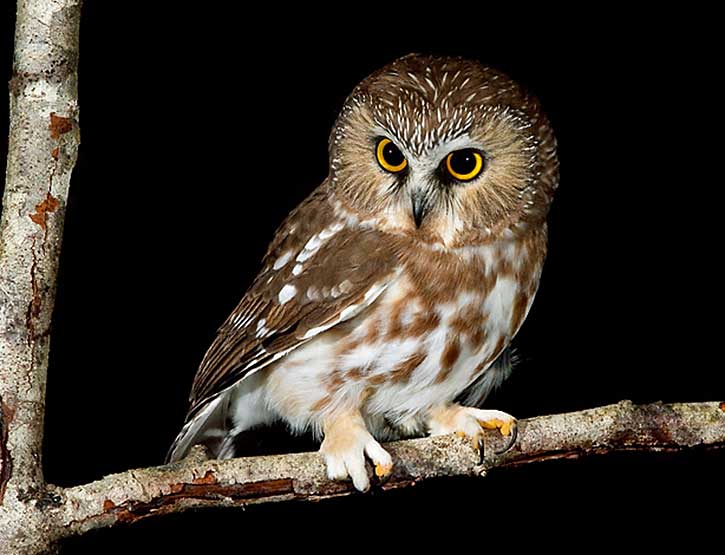
Northern Saw-whet Owls look pretty similar to the Boreal Owls. Both species have a similar shape with a rounded or slightly-square-shaped head, brown markings on their underparts, and yellow eyes.
However, the Boreal Owl is more of a dark brown bird, and has a black and white face. It also has small white spots on the top of its head.
Northern Hawk Owl
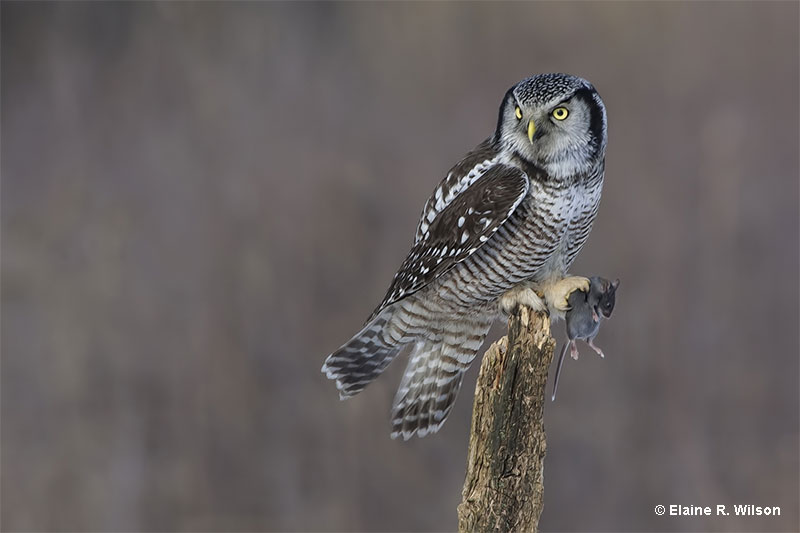
© Elaine R. Wilson
The Northern Hawk Owl is sometimes confused with the Boreal Owl because of its similar head pattern and coloration.
However, unlike the Boreal Owl, it is a bigger and slenderer bird. Northern Hawk Owls also have barred underparts, a long tail, and are active during the day.
Eastern Screech-Owl
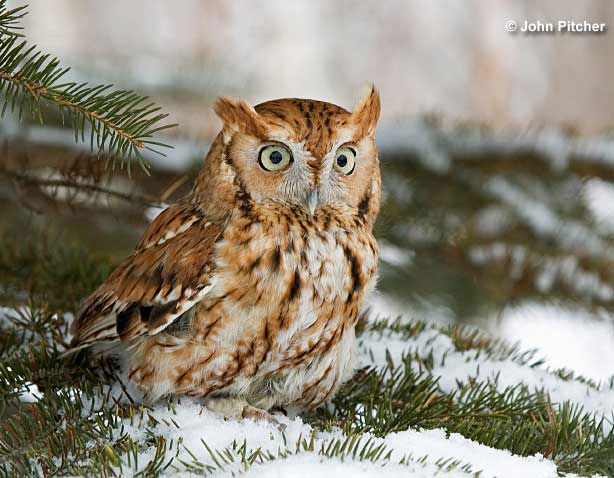
Eastern Screech-Owls look quite different from the Boreal Owl. However, since they can be similar in size and are found in some of the same places, these two birds are sometimes confused with each other.
The easiest way to separate them is to look at the head and front part of the bird. Unlike Boreal Owls, Eastern Screech-Owls have ear tufts, and fine streaks and barring on their underparts.
Frequently Asked Questions
Where do Boreal Owls live?
Boreal Owls live in cold, northern and mountain forests in Alaska, Canada, the Rocky Mountains, and northern Eurasia.
Are Boreal Owls endangered?
No, Boreal Owls are not endangered. However, they are difficult to see because they are nocturnal and mostly live in remote areas.
Where is the best place to see a Boreal Owl?
The best place to see a Boreal Owl is in conifer stands in Alaska, southern Canada, and the northern USA in the winter. Some of the most reliable wintering sites to see Boreal Owls are near Toronto, Canada and other sites on the northern shore of Lake Ontario.
How do you identify a Boreal Owl?
You identify a Boreal Owl by its small size, spotted back, black and white head, pale beak, and yellow eyes.

